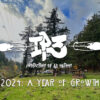|
Getting your Trinity Audio player ready...
|
After decades long advocacy by the Yurok, Karuk, Shasta, Klamath, Modoc and other tribes of Southern Oregon and Northern California, and following the largest dam removal in United States history, our salmon relatives are once again swimming freely in the Klamath Basin. On October 16th, 2024, fall-run Chinook were spotted above the former site of the J.C. Boyle Dam, one of four dams that blocked access to salmon migration and spawning habitat since 1956. As biologists anticipated migration and spawning could take years or even decades to restore, the Salmon’s return was observed just weeks after the final obstruction was removed from the southernmost barrier at the former Iron Gate Dam location on September 26th. In addition to the return of fall-run Chinook, an adult Pacific lamprey was seen swimming through the California Department of Fish and Wildlife fish counting station at Jenny Creek on October 1st, marking the significance that ancestral and genetic memory are still alive and present in these fish, and that pre-contact ecosystems can be restored when federal agencies shift from inferior post-colonial land practices to Indigenous Knowledge and Landback. We are witnessing in real time that consistent Nonviolent Direct Action strategies work when we stay committed to our traditional life ways.
In 2002, an estimated 70,000 salmon died as a result of PacifiCorp withholding water behind the Iron Gate Dam, diverting it to farms instead of letting it flow downstream, a tragedy felt among tribal communities and advocates to this day. In an interview with Ian James of the Los Angeles Times, Karuk tribal member and traditional fisherman, Ron Reed says he’s not surprised that the fish have returned so quickly to their ancestral waters, and “the fact that the fish are going up above the dams now, to the most prolific spawning and rearing habitat in North America, it definitely shines a very bright light on the future. Because with those dams in place, we were looking at extinction. We were looking at dead fish.” Among the long list of problems the dams created for communities and wildlife on the Klamath River since their completion in 1962, they also contributed to algae blooms and diseases, blocking the salmon’s annual migration. The mass salmon deaths and near extinction of these fish sparked decades of advocacy from the tribes, and in November of 2022, the Federal Energy Regulatory Commission approved a $500 million project to remove the Iron Gate Dam, Coco Dams 1 and 2, and the J.C. Boyle Dam. With the last of the dams infrastructure being removed in January of 2024, the Klamath River flowed freely by the end of August, and for the first time in over a century.
In a study conducted by the National Oceanic and Atmospheric Administration of salmon and other fish, biologists say that that populations of Chinook salmon could be sustainable in 15 to 20 years, and Coho salmon in 6 to 12 years. According to Traditional Ecological Knowledge, or Indigenous Knowledge held by tribal historians and elders, communities are optimistic that populations can be restored even sooner and include other species including Pacific lamprey, steelhead, northwestern pond turtle, beavers, and otters. Among species being reintroduced to their traditional homes on the Klamath River, none of this would be possible without the inclusion of Indigenous and place-based knowledge. Thinking about what plant species to include, where they occur naturally on the landscape, and their cultural significance has been at the core of the restoration, and we know through over a hundred years of environmental failures that Klamath Indigenous Knowledge and Landback are cornerstone in restoration efforts. It is astounding to imagine how disconnected one must be to ever convince settlers of the day that these dams had any value when we knew the devastating impact they would have on generations since. We are hopeful they will think twice before dismissing our voices as we work to clean up their mess for generations to come. We remember where we came from.
In Solidarity,
Indigenous Peoples Power Project









